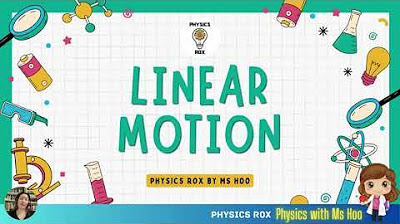Time Speed and Distance 1 | CAT | XAT | IIFT | Arithmetic | Quantitative Aptitude | Udit Saini
Summary
TLDRThe video script is an educational tutorial focusing on the 'Time, Speed, and Distance' topic, a common subject in competitive exams like CAT and aptitude tests. The instructor welcomes viewers to the channel and introduces the concept using a simple formula: Distance = Speed * Time. They clarify the relationship between speed and time, emphasizing that when distance is constant, speed and time are inversely proportional. The script includes examples to demonstrate how to calculate speeds in different units and convert between them. The instructor also discusses various types of questions, such as those involving constant distance and average speed, providing shortcuts and strategies for solving them efficiently. The session aims to make the chapter easy to understand and prepare for exams.
Takeaways
- 😀 The video is a tutorial aimed at helping viewers understand the concept of Time, Speed, and Distance, which is a common topic in various exams.
- 🏫 The presenter emphasizes that the session will be particularly useful for individuals preparing for exams like the CAT, campus placements, or any aptitude tests.
- 📚 The entire series on Time, Speed, and Distance is promised to be comprehensive, with all sessions available in the video description for easy access.
- 🔗 The presenter encourages viewers to subscribe to the YouTube channel, MBA Pathshala, and join their Telegram channel for updates and the full playlist of topics.
- 📈 The video explains the basic formula for Time, Speed, and Distance: Distance = Speed * Time, Speed = Distance / Time, and Time = Distance / Speed.
- ⏱️ The units of measurement for Time are discussed, such as seconds and hours, and the units for Distance are mentioned as meters and kilometers.
- 📉 The concept of converting speed units from meters per second to kilometers per hour and vice versa is covered, with the multiplication factors 18/5 and 5/18.
- 📐 The video introduces the idea of 'Distance Constant' problems, where the distance remains the same regardless of the speed, and how to approach such questions.
- 🤔 The presenter discusses the inverse proportionality concept, stating that if speed increases, time decreases, and vice versa, which is key to solving Time, Speed, and Distance problems.
- 📝 The script includes an example problem to demonstrate the application of the concepts discussed, involving a person traveling at a certain speed and the calculation of time taken.
Q & A
What is the main topic discussed in the video script?
-The main topic discussed in the video script is 'Time, Speed, and Distance', which is a common topic in competitive exams and is covered extensively in the context of various entrance exams.
What are the basic formulas for Time, Speed, and Distance mentioned in the script?
-The basic formulas mentioned are: Time = Distance/Speed, Speed = Distance/Time, and Distance = Speed * Time.
What is the significance of the 7/11 ratio in the script?
-The 7/11 ratio is used to illustrate the concept of speed and time being inversely proportional when the distance is constant. It is used to explain how a change in speed affects the time taken to cover a certain distance.
How does the script suggest converting speed from meters per second to kilometers per hour?
-The script suggests multiplying the speed in meters per second by 18/5 to convert it to kilometers per hour, and vice versa, multiply by 5/18 to convert from kilometers per hour to meters per second.
What is the concept of 'Distance Constant' explained in the script?
-The 'Distance Constant' concept refers to situations where the distance to be covered is fixed, and the script explains how changes in speed affect the time taken to cover that distance.
What is the example given in the script to demonstrate the concept of 'Distance Constant'?
-The example given is of two siblings, Ram and Radha, who travel from home to school at different speeds. The script uses this example to explain how the time taken to cover the same distance varies inversely with the speed when the distance is constant.
How does the script suggest solving problems when the distance is constant?
-The script suggests solving problems by using the inverse proportionality of speed and time when the distance is constant. If the speed increases, the time decreases, and vice versa.
What is the importance of understanding the concept of inverse proportionality in the context of the script?
-Understanding the concept of inverse proportionality is important because it helps in quickly solving problems related to time and speed when the distance is constant, which is a common scenario in competitive exams.
What is the challenge given to the viewers at the end of the script?
-The challenge given to the viewers is to solve a problem involving a car running at 7/11 of its original speed and reaching a place in 22 hours, and then to calculate the time it would take if it ran at its original speed.
How does the script encourage viewers to practice and engage with the content?
-The script encourages viewers to practice by solving the challenge problem and posting their answers in the comment section, with the promise of solving it in the next video, thus engaging them with the content and promoting active learning.
Outlines

このセクションは有料ユーザー限定です。 アクセスするには、アップグレードをお願いします。
今すぐアップグレードMindmap

このセクションは有料ユーザー限定です。 アクセスするには、アップグレードをお願いします。
今すぐアップグレードKeywords

このセクションは有料ユーザー限定です。 アクセスするには、アップグレードをお願いします。
今すぐアップグレードHighlights

このセクションは有料ユーザー限定です。 アクセスするには、アップグレードをお願いします。
今すぐアップグレードTranscripts

このセクションは有料ユーザー限定です。 アクセスするには、アップグレードをお願いします。
今すぐアップグレード関連動画をさらに表示

BEST Mock Test Strategy for JEE Mains 2024 #mocktest #jee

Linear Motion - Distance, Displacement, Speed, Velocity, Acceleration - SPM & IGSCE Physics

Subject Verb Agreement | Rules In English Grammar With Examples | Subject Verb Concord | ChetChat

5 Tips to Write Exam Like Topper🤯| How to Write Answers on Your own| Prashant Kirad

I scored 99.42 percentile in CAT Quant despite weak Math

Lec-10: Two 2️⃣ Pointer👆 Technique | Two 2️⃣ Sum Problem in Data Structure
5.0 / 5 (0 votes)
